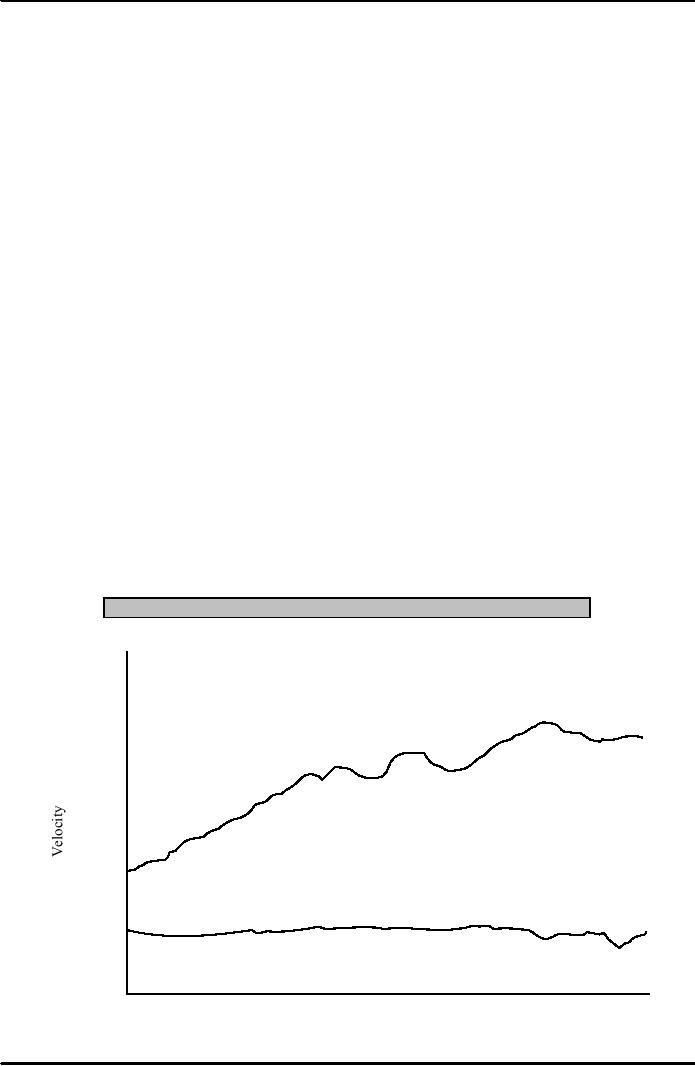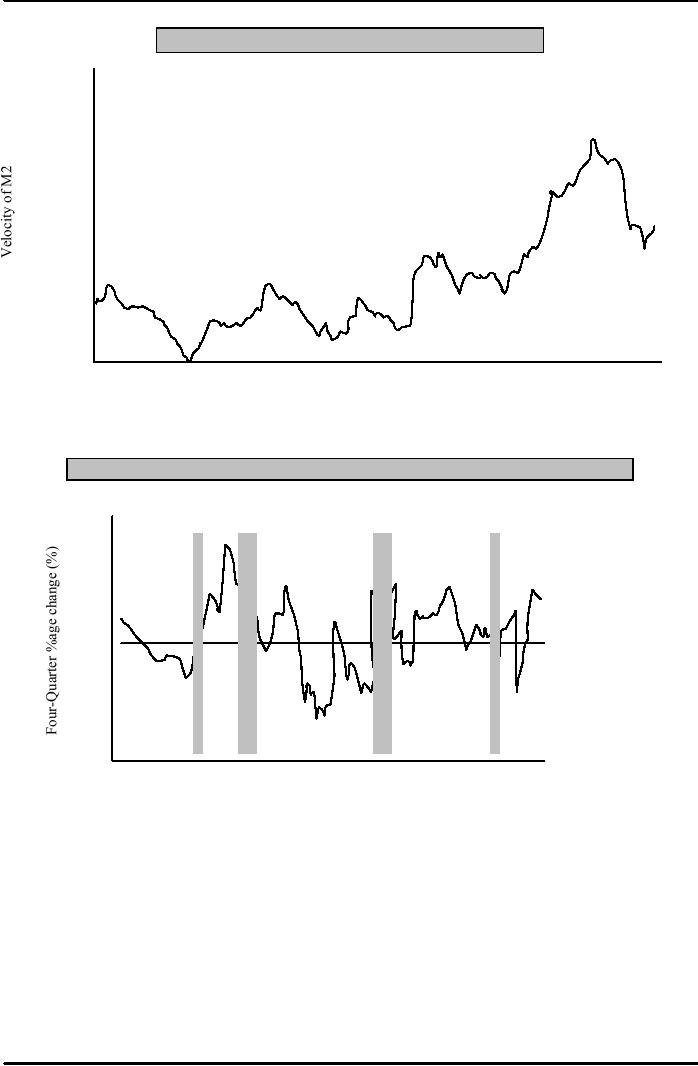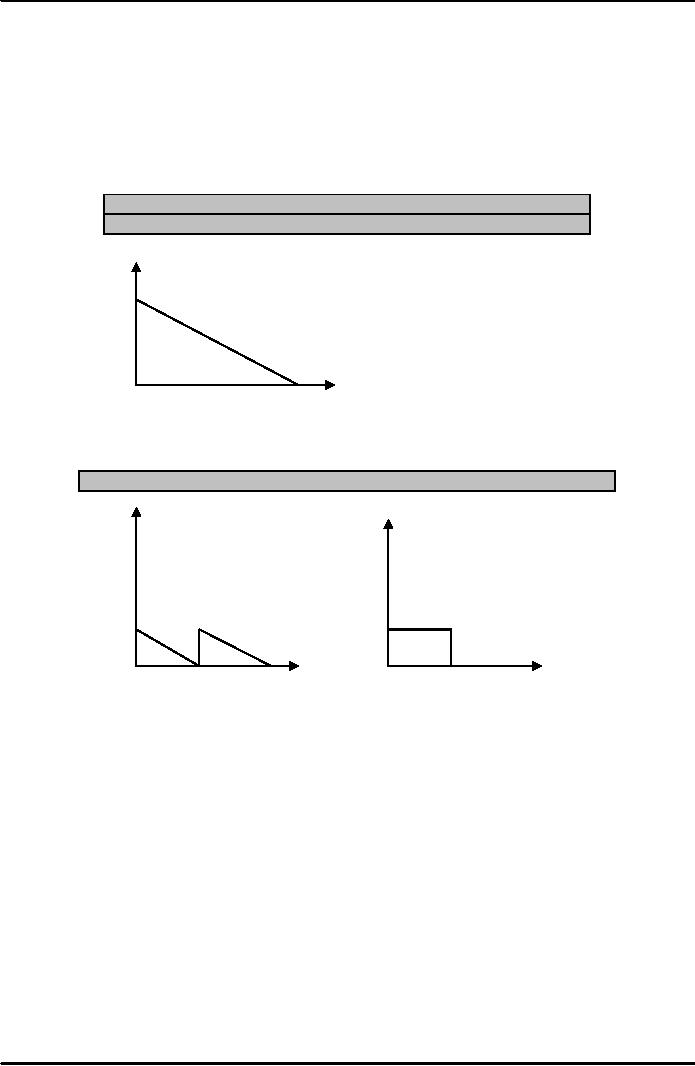 |

Money
& Banking MGT411
VU
Lesson
38
THE
FACTS ABOUT
VELOCITY
Fisher's
logic led Milton Friedman to
conclude that central banks
should simply set
money
growth
at a constant rate.
Policymakers
should strive to ensure that
the monetary aggregates grow at a rate
equal to the
rate
of real growth plus the desired
level of inflation.
Knowing
that the multiplier is a variable,
Friedman suggested changes in
regulations that
would
Limit
banks' discretion in creating
money
Tighten
the relationship between the monetary
aggregates and the monetary
base.
However,
even with Friedman's recommendations, the
central bank would stabilize
inflation by
keeping
money growth constant only
if velocity were constant.
In
the long run, the velocity of
money is stable, though there can be
significant short-run
variations.
From
the point of view of policymakers,
these fluctuations in velocity
are enormous.
Assuming
that central bank can
accurately control the growth rate of M2
as well as accurately
forecast
real growth.
Money
Growth + Velocity Growth =
Inflation + Real Growth
With
an inflation objective of 2% and a real
growth forecast of 3.5%,
equation of exchange
tells
us
that policy makers should
set money growth 5.5% minus
the growth rate of velocity.
If
velocity increases by 3% then
money growth needs to be
2.5%
If
it falls by 3% then money
growth needs to be
8.5%
When
inflation is low, short run
velocity growth can be several times the
policy makers'
inflation
objectives.
So
to use money growth targets
to stabilize inflation, policy
makers must understand
how
velocity
changes
Fluctuations
in velocity are tied to
changes in people's desire to
hold money and so in order
to
understand
and predict changes in velocity;
policymakers must understand the demand
for
money.
Figure:
Velocity of M1 and M2 (on the
same vertical scale)
10
___M1
Velocity ____M2 Velocity
9
8
7
6
5
4
3
2
1
0
1959
1963 1967 1971 1975
1979 1983 1987 1991
1995 1999 2003
119

Money
& Banking MGT411
VU
Figure:
Velocity of M2 (on its own
scale)
2.2
2.1
2.0
1.9
1.8
1.7
1.6
1959
1963 1967 1971 1975
1979 1983 1987 1991
1995 1999 2003
Years
Figure:
Percentage change in the short-run
velocity of M2, 1960-2004
8
6
4
2
0
-2
-4
-6
-8
1975
1980
1985
1990
1995
2000
Years
The
Transactions Demand for
Money
The
quantity of money people
hold for transactions
purposes depends on
Their
nominal income,
The
cost of holding
money,
The
availability of substitutes
Nominal
money demand rises with
nominal income, as more income
means more spending,
which
requires more money
Holding
money allows people to make
payments, but has cost of interest
foregone.
There
may also be costs in
switching between interest-bearing assets
and money.
Example
120

Money
& Banking MGT411
VU
If
your monthly earning is
Rs.30, 000 (deposited in bank
each month) and assuming you
spend
Rs.1,
000 each day, after 15
days your checking account
balance will decline to
Rs.15, 000 and
to
zero on 30th day
Your
bank offers you a choice of
leaving the entire 30,000 in the
account or shifting funds
back
and
forth between checking and a bond
fund.
The
bond fund pays interest but
adds a service charge of Rs.20
for each withdrawal.
How
would you manage your
funds and what should be
your frequency of shifting the
funds
between
the bond fund and checking
account?
Consider
the following alternatives.
Two
alternatives for managing
your cash balance
Strategy
1: Leave entire balance in checking
account
Checking
account balance
Bond
fund
30,000
balance
is zero
throughout
the
month.
30
0
Day
of the month
Strategy
2: Transfer half to bond fund,
then transfer back at
mid-month
Bond
Fund Balance
Checking
account
balance
15,000
15,000
15
0
0
30
15
30
Day
of the Month
Day
of the month
Your
choice depends upon the interest rate you
receive on the bond
fund
If
interest income is at least as much as
the service charge then you
will split your pay
check at
the
beginning of the month.
Otherwise
you will not want to
invest in bond fund.
If
you shift half your
funds once , at the middle of the
month, you'll have Rs.15,000 in
bond
fund
during the first half of the
month and Rs.0 during the
second half, so your average
balance
will
be Rs.7,500.
Making
shift will cost you
Rs.20 so if the interest on Rs.7, 500 is
greater than 20, you
should
make
the shift.
At
monthly interest rate of 0.27%, Rs.7,
500 will produce an income of
Rs.20
(20
/ 7500= 0.0027)
So
if bond fund offers a higher
rate you should make the
shift.
As
the nominal interest rate rises, people
reduce their checking
account balances, which
allow
us
to predict that velocity
will change with the interest
rate.
Higher
the nominal interest rate, the less money
individuals will hold for a
given level of
transactions,
and higher the velocity of
money
121

Money
& Banking MGT411
VU
The
transactions demand for
money is also affected by
technology, as financial
innovation
allows
people to limit the amount of money
they hold.
The
lower the cost of shifting
money between accounts, the lower the
money holdings and the
higher
the velocity.
Suppose
your bank offers free
automatic transfer account. You sign up
for it but continue
using
your
old check and debit
account
Your
take home pay is the same
Rs.30, 000. Each time
you make a purchase, your
bank
automatically
shifts the amount of purchase from
your bond fund to your
checking account
where
it remains for one day
before being paid to your
creditor.
Spending
your Rs.30,000 in 30 days, your
average money holding will
be Rs.1000 far below
Rs.1,500
you would hold if you
simply left the 30,000 in
your checking account and
spent it at a
rate
of Rs.1,000 per day
So
lower the cost of shifting
funds from your bond
fund to your checking account, the
lower
your
money holdings at a given
level of income and the higher the
velocity of your
money
An
increase in the liquidity of stocks,
bonds, or any other asset
reduces the transactions
demand
for
money.
People
also hold money to ensure
against unexpected expenses; this is
called the precautionary
demand
for money and can be
included with the transactions
demand.
The
higher the level of uncertainty
about the future, the higher the
demand for money and
the
lower
the velocity of money
The
Portfolio Demand for
Money
Money
is just one of many financial instruments
that we can hold in our
investment portfolios.
Expectations
that interest rates will
change in the future are
related to the expected return on
a
bond
and also affect the demand
for money.
122
Table of Contents:
- TEXT AND REFERENCE MATERIAL & FIVE PARTS OF THE FINANCIAL SYSTEM
- FIVE CORE PRINCIPLES OF MONEY AND BANKING:Time has Value
- MONEY & THE PAYMENT SYSTEM:Distinctions among Money, Wealth, and Income
- OTHER FORMS OF PAYMENTS:Electronic Funds Transfer, E-money
- FINANCIAL INTERMEDIARIES:Indirect Finance, Financial and Economic Development
- FINANCIAL INSTRUMENTS & FINANCIAL MARKETS:Primarily Stores of Value
- FINANCIAL INSTITUTIONS:The structure of the financial industry
- TIME VALUE OF MONEY:Future Value, Present Value
- APPLICATION OF PRESENT VALUE CONCEPTS:Compound Annual Rates
- BOND PRICING & RISK:Valuing the Principal Payment, Risk
- MEASURING RISK:Variance, Standard Deviation, Value at Risk, Risk Aversion
- EVALUATING RISK:Deciding if a risk is worth taking, Sources of Risk
- BONDS & BONDS PRICING:Zero-Coupon Bonds, Fixed Payment Loans
- YIELD TO MATURIRY:Current Yield, Holding Period Returns
- SHIFTS IN EQUILIBRIUM IN THE BOND MARKET & RISK
- BONDS & SOURCES OF BOND RISK:Inflation Risk, Bond Ratings
- TAX EFFECT & TERM STRUCTURE OF INTEREST RATE:Expectations Hypothesis
- THE LIQUIDITY PREMIUM THEORY:Essential Characteristics of Common Stock
- VALUING STOCKS:Fundamental Value and the Dividend-Discount Model
- RISK AND VALUE OF STOCKS:The Theory of Efficient Markets
- ROLE OF FINANCIAL INTERMEDIARIES:Pooling Savings
- ROLE OF FINANCIAL INTERMEDIARIES (CONTINUED):Providing Liquidity
- BANKING:The Balance Sheet of Commercial Banks, Assets: Uses of Funds
- BALANCE SHEET OF COMMERCIAL BANKS:Bank Capital and Profitability
- BANK RISK:Liquidity Risk, Credit Risk, Interest-Rate Risk
- INTEREST RATE RISK:Trading Risk, Other Risks, The Globalization of Banking
- NON- DEPOSITORY INSTITUTIONS:Insurance Companies, Securities Firms
- SECURITIES FIRMS (Continued):Finance Companies, Banking Crisis
- THE GOVERNMENT SAFETY NET:Supervision and Examination
- THE GOVERNMENT'S BANK:The Bankers' Bank, Low, Stable Inflation
- LOW, STABLE INFLATION:High, Stable Real Growth
- MEETING THE CHALLENGE: CREATING A SUCCESSFUL CENTRAL BANK
- THE MONETARY BASE:Changing the Size and Composition of the Balance Sheet
- DEPOSIT CREATION IN A SINGLE BANK:Types of Reserves
- MONEY MULTIPLIER:The Quantity of Money (M) Depends on
- TARGET FEDERAL FUNDS RATE AND OPEN MARKET OPERATION
- WHY DO WE CARE ABOUT MONETARY AGGREGATES?The Facts about Velocity
- THE FACTS ABOUT VELOCITY:Money Growth + Velocity Growth = Inflation + Real Growth
- THE PORTFOLIO DEMAND FOR MONEY:Output and Inflation in the Long Run
- MONEY GROWTH, INFLATION, AND AGGREGATE DEMAND
- DERIVING THE MONETARY POLICY REACTION CURVE
- THE AGGREGATE DEMAND CURVE:Shifting the Aggregate Demand Curve
- THE AGGREGATE SUPPLY CURVE:Inflation Shocks
- EQUILIBRIUM AND THE DETERMINATION OF OUTPUT AND INFLATION
- SHIFTS IN POTENTIAL OUTPUT AND REAL BUSINESS CYCLE THEORY